Conservation and restoration of panel paintings
The conservation and restoration of panel paintings involves working with an object that is composed of two media: wood and paint. The process of conservation and restoration of paintings on canvas is different from that of panel paintings. In the United States, it is recommended that conservation practices follow the "Code of Ethics" set by the American Institute for Conservation of Historic and Artistic Works.[1]
Preventive care
Preventive care is a form of conserving panel paintings. Improper storage conditions, environmental conditions, and handling can act as catalysts in damaging effects. These include chemical and structural damage, seen through skin oils and degradation that can be caused by high humidity or high temperature levels. The conservation of panel paintings can be achieved by a series of methods, including:
Handling
The recommended handling method of panel paintings is similar to that of canvas paintings and other two-dimensional works. The procedure includes planning the move, handling with two hands or in tandem, communication within the handling staff during the move, the use of nitrile gloves, the use of painting carts and other tools including a pallet jack or furniture dolly when moving a panel painting within a crat. The Metropolitan Museum of Art, the Canadian Conservation Institute, and the Australian Institute for the Conservation of Cultural Material provide general handbooks that discuss the proper handling and care of paintings.

Storage
Typical storage units in museums include sliding screens or slotted shelves made out of MDF and heat treated wood coated in polyurethane. "S" Hooks are used to hang objects with the proper hanging hardware (e.g. D-Rings or eye brackets with picture wire) onto the screen. Temporary storage solutions include the use of ethafoam, moving/packing blankets, and archival corrugated cardboard.
Environmental conditions
Fluctuating humidity and temperatures can lead to smaller problems within the structure and painted surface that in the long-term accumulate. In panels that are made up of multiple pieces of wood composing the larger surface area, the damage can be visible where the pieces of wood are attached.[2] Temperatures should range between +/- 5% of 70°F and the humidity between +/- 5% of 50% Relative Humidity. A Relative Humidity over 65% can lead to mold growth and dry rot.[3]
In exhibitions panel paintings are subjected to various environmental conditions. The exhibition conditions must also be regulated to conserve the painting. These factor includes temperature, humidity , light intensity and duration of exposure, and air and atmospheric pollutants. There must be sufficient air filters attached to the HVAC system to reduce the air pollutants within the air in gallery/exhibition spaces along with storage areas (via reducing gases potentially emitted by various objects). Light levels must be at approximately 50-200 Lux as there is an irreversible light lifetime per panel painting.[4]
Integrated pest management
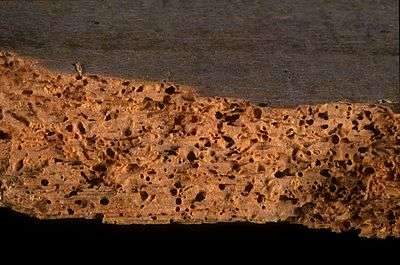
Integrated Pest Management policies are created to reduce or limit any problems relating to pests damaging objects within collections. Concepts discussed in Integrated Pest Management Policies include restricting food and sugary drink consumption in exhibition, storage areas and surrounding areas along with maintaining cleanliness in exhibition and storage areas.
Examples of causes of damage
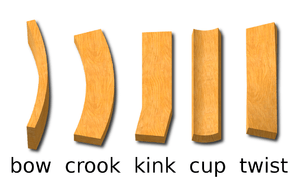
Damage can also come from:
- Improper Relative Humidity
- Low Humidity reduces the chemical changes but raises the risks of mechanical damage to the paint by making it more brittle.[5]
- High Humidity reduces mechanical damage but raises the risks of biological organisms, e.g. white efflorescence and green-to-black stains.[6]
- High Humidity also raises the risks of curving of the wood over time, forcing the paint to flake off.
- Flooding will cause swelling as seen in a case study by the Getty Conservation Institute.[7]
- Improper Temperature
Examination
Structural
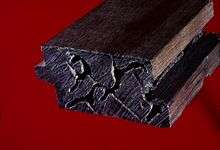
Proper examination of the object is an initial step in the conservation process. Commonly used technologies include radiography and reflectography. Radiography provides the effective technique in terms of analyzing the condition and preservation work done on the structure of panel paintings. Other uses of radiography can be seen by the opaqueness of specific colors used in the painting, condition of the wood, thickness or density of the wood, and various damage done by pests.[8][9] Furniture and Larder Beetles can burrow into wood. Illustrations of these beetles can be found on the Insects Limited Incorporated website,[10] and other examples can be found through Museumpests.net's page.[11] website.
Surface and painting
Photographic documentation and the use of magnification with the naked eye used with diffuse and raking light are common methods used at art museums like the Tate Museum in the United Kingdom, these are effective tools for initial observation. Causes for damage in the surface of panel paintings can be caused by the structural issues in the wood, these include damage done by wood-boring pests. Damage to the painting can also be caused by the fluctuation of temperatures and relative humidity levels.
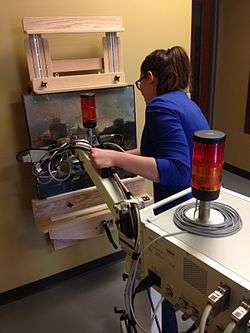
Examples of technology
- Reflectance transformation imaging is a type of computational photography that uses digital computation instead of optical processes to create new data as seen with the Penn Museum's Fayum Mummy Portraits.[12]
- X-ray fluorescence is a non-destructive analytical technique used to determine the elemental composition of materials.[13] This technique has been employed in the Ophelia painting at the Tate museum.[14]
- Multispectral imaging
- X-Ray radiography
- Ultraviolet light - This technique has been employed in the Ophelia painting at the Tate museum.[14][15]
- Infra-red reflectography - This technique has been employed in the Tate Museum[16][14]
Treatments
Structural
Pests can cause damage to the wood panels used in panel paintings. The pests must be eradicated prior to conservation to ensure the longevity of the object and the conservation work. Examples of treatments include:
- Isolation through bagging - putting the object in isolation with blotter paper, paper board, tissue or foam sealed in a polyethylene bag and monitored over several weeks or months.
- Low Temperature - typically putting the object into a freeze (qualified for this type of use). The freezer must reach -20°F (-29°C) and objects must be put into the freezer inside a resealable plastic bag to be froze during 4 hours.
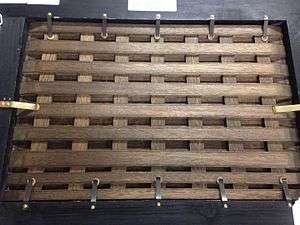
Conservators must adapt to the specific case of each panel and must use their experience to their advantage. Structures used in conservation include:
- Custom strainers that are curved to match the panel with springs to safely flex.
- Cradling - Cradling refers to the addition of support on the rear part of the panels. These must have flexibility to allow for some movement from slight temperature and humidity changes.
- Adhesives - If there is a simple crack within the panel, adhesives are used in combination of alignment, and moderate compression. All adhesives used must adhere to the "Code of Ethics" and must be reversible.
Treatment of adhesives include:
- Reactivation of hide glues.
- Adding water-based emulsion glues to existing and failing adhesives.
- Replacing failed adhesives with new ones.
Examples of adhesives include:[17]
- Natural protein adhesives - found through animal products such as casein, albumin, fish glue, and animal-hide glue.
- Natural resins - often seen in historic objects.
- Synthetic resin adhesives - "aqueous emulsions of polyvinyl acetate (PVA) and are commonly called “white” glues"[17]
Transfer of Panel Paintings - The transferral of a painting from an often unstable panel to another panel is considered to be a delicate process. This process occurs when there has been a form of degradation in the original panel (possible causes include pest damage (burrowing), warping, or the thinning of the panel). The transfer should be made to a similarly aged panel, made out of the same wood type. The National Gallery in the United Kingdom provides an example with Raphael's Virgin and Child.[18]
When a panel is submerged due to flooding, the recommended procedure is to expose the panel painting through a long drying process prior to any further conservation work.
Surface and painting
The conservation of paintings varies for the different types of oil, acrylic and fresco paintings. These techniques include cleaning, removal and replacement of degraded varnish and the restoration of paint losses. The Tate Museum described that "Cleaning is a particularly delicate and demanding part of conserving and restoring paintings. Layers of dirt, discoloured varnish and old restorations that may be disfiguring or obscuring parts of the composition are painstakingly removed."[19]
The evolution of modern paints, that can be used in panel paintings, has contributed to facilitate conservation. "The introduction of synthetic binders—most notably acrylic, alkyd, polyvinyl acetate, and nitrocellulose—has resulted in paints that exhibit fast drying times, reduced yellowing tendencies, a vast range of appearances and handling properties and, in the case of emulsion formulations, great flexibility and the elimination of organic solvents as thinners and diluents.[20]
Outreach
The Penn Museum, based out of Philadelphia (Pennsylvania), created the Artifact Lab where visitors interact with content related to the museum. The webpage provides a blog and other relevant pages relating to their Artifact Lab and its operations. It has a blog section discussing topics from general cleaning (with objects under different lights), to the use of various scanning technologies (such as X-radiography).[21]
References
- "Code of Ethics and Guidelines for Practice". www.conservation-us.org. Retrieved 5 April 2017.
- J. Paul Getty Museum (1998). The Structural Conservationof Panel Paintings. 1998: The J. Paul Getty Trust. pp. 318–319. ISBN 9780892363841.CS1 maint: location (link)
- "Paintings and their Environment". The National Gallery.
- Canadian Conservation Institute. "Environmental Guidelines for Paintings - Canadian Conservation Institute (CCI) Notes 10/4". Government of Canada.
- Alten, Helen (Fall 1999). "Temperature and Relative Humidity". Northern States Conservation Center.
- Ciferri, Orio. "Microbial Degradation of Paintings". American Society for Microbiology.
- "Current Approaches to the Structural Conservation of Panel Paintings: Part Four".
- Murray, Alison (1996). "Air-Coupled Ultrasonic System: A New Technology For Detecting Flaws In Paintings On Wooden Panels". Journal of the American Institute for Conservation.
- "Current Approaches to the Structural Conservation of Panel Paintings" (PDF). The Getty Conservation Institute. October 29, 1998.
- "Insects Limited Incorporated".
- "Museumpests: Identification".
- "Penn Museum: Fayum Mummy Portraits".
- "XRF (X-ray Fluorescence)".
- "Tate Museum: Ophelia painting".
- "Tate Museum: Ophelia painting: UV".
- "Tate Museum: Infra-red reflectography".
- Williams, Donald C. (April 1995). "A Survey of Adhesives for Wood Conservation" (PDF).
- "National Gallery: Raphael's Virgin and Child".
- "Conservation – paintings". The Tate Museum.
- "Modern Paints". The Getty Conservation Institute.
- "Penn Museum: Artifact Lab".
External links
- The Getty Conservation Institute has multiple resources through a YouTube Playlist on Panel Paintings Conservation and the Panel Painting Initiative page on their website
- Victoria and Albert's Conservation Treatment of a 17th Century English Panel Painting
- The Metropolitan Museum of Art's A Treatment for Panel Paintings
- Asian Art Museum's Conservation of a South Asian Painting